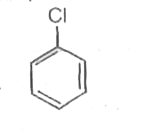To solve the given question, we will follow the steps involved in the reaction of propene (CH₃CH=CH₂) with bromotrichloromethane (BrCCl₃) in the presence of peroxide. This reaction involves the formation of free radicals and follows the anti-Markovnikov rule.
1. Identify the Reactants:
- The reactant is propene (CH₃CH=CH₂) and bromotrichloromethane (BrCCl₃).
- The presence of peroxide indicates that the reaction will proceed via a free radical mechanism.
2. Formation of Free Radicals:
- In the presence of peroxide, the BrCCl₃ will dissociate to form bromine radicals (Br•) and trichloromethyl radicals (CCl₃•).
- The reaction can be represented as:
BrCCl3Peroxide−−−−−→Br∙+CCl3∙
3. Radical Addition to Propene:
- The bromine radical (Br•) will add to the less substituted carbon of propene (the terminal carbon), following the anti-Markovnikov rule.
- This results in the formation of a more stable radical at the more substituted carbon (the middle carbon).
- The reaction can be represented as:
CH3CH=CH2+Br∙→CH3C(Br)CH2∙
4. Formation of the Final Product:
- The trichloromethyl radical (CCl₃•) will then react with the radical formed in the previous step.
- This leads to the final product:
CH3C(Br)CH2CCl3
- Therefore, the final product is:
CH3CHBrCH2CCl3
Final Answer:
The product of the reaction is CH₃CHBrCH₂CCl₃.
---
- The reactant is propene (CH₃CH=CH₂) and bromotrichloromethane (BrCCl₃).
- The presence of peroxide indicates that the reaction will proceed via a free radical mechanism.
- In the presence of peroxide, the BrCCl₃ will dissociate to form bromine radicals (Br•) and trichloromethyl radicals (CCl₃•).
- The reaction can be represented as:
BrCCl3Peroxide−−−−−→Br∙+CCl3∙
- The bromine radical (Br•) will add to the less substituted carbon of propene (the terminal carbon), following the anti-Markovnikov rule.
- This results in the formation of a more stable radical at the more substituted carbon (the middle carbon).
- The reaction can be represented as:
CH3CH=CH2+Br∙→CH3C(Br)CH2∙
- The trichloromethyl radical (CCl₃•) will then react with the radical formed in the previous step.
- This leads to the final product:
CH3C(Br)CH2CCl3
- Therefore, the final product is:
CH3CHBrCH2CCl3
The product of the reaction is CH₃CHBrCH₂CCl₃.
Similar Questions
Write the structure of the major organic product in each of the following reactions:
a. CH3CH2CH2Cl+NalAccetoneHeat
b. (CH3)3CBr+KOHEthanolHeat
c. CH3CH(Br)CH2CH3+NaOHWater−−−→
<br>d.CH_(3)CH_(2)CH = CH_(2) + HBr overset("Peroxide")
View SolutionComplete the reaction
CH3CH=CH2+HBrPeroxide−−−−→
View Solution
Knowledge Check
For each of the following pairs ofE2 reaction, selectthe one thatoccurs withthe greaterrate constant
(1) CH3CH2CH2Cl+CH3−CH3∣C∣CH3−O−
(2) CH3CH2CH2I+CH3−CH3∣C∣CH3−O−
(3) H3C−C∣BrH−CH3+CH3O−
(4) H3C−C∣BrH−CH3+CH3S−
 A2,4,6B1,3,5C2,3,5D2,4,5
A2,4,6B1,3,5C2,3,5D2,4,5The reaction CH2=CH−CH3+HBr→CH3−Br∣CHCH3 is
Anucleophilic additionBfree radical additionCelectrophilic additionDelectrophilic substitutionThe products (A) and (B) are respectively.
(i) CH3−CH∣Br−CH∣CH3−CH3C2H5ONa−−−−−→(A)
(ii) CH2=CH3∣C−CH2CH3HBr−−−−→Peroxide(B)ACH3−C∣BrH−C∣CH3H−CH3C2H5ONa−−−−−→(A)BCH2=CH3∣C−CH2CH3Hbr−−−−→Peroxide(B)CCH3CH2−CH3∣CH−CH3,CH3(CH2)2CH3DCH3CH2−C∣OC2H5(CH3),C∣BrH2−CH∣CH3−CH2−CH2
Which of the following is correct for
CH_(3)- CH= CH_(2) overset(HBr)underset("Peroxide")(to) ?
View SolutionDraw the structure of the major monohalo product in each of the CH3CH2−C∣CH3=CH2+HBrperoxide−−−−→
View SolutionCH3−C∣CH3=CH2HBr−−−−→PeroxideCH3−CH∣CH3−CH2Br reaction intermediate of this reaction is:
View SolutionThe correct order of reactivity of the following compounds towards aqueous NaCN will be
I
II. CH2=CH−CH2−Cl
III. CH3−Cl∣CH−CH3 IV. CH2=CH−CH2−Br
View SolutionWhat is the product of the following reaction : CH3−C∣CH3=CH2HBr−−−−→Peroxide
View Solution
